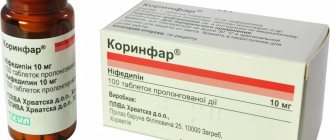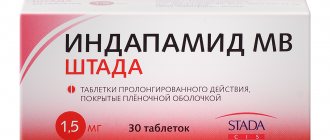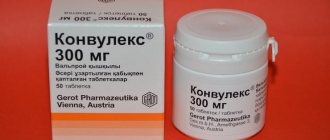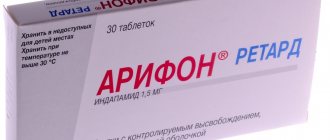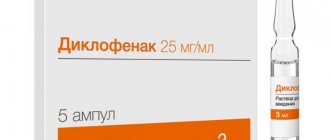Information about the drug
Blood pressure medicine Cordaflex is a drug characterized by the presence of powerful antihypertensive properties. It has a prolonged effect, which allows you to avoid frequent use of the medication.
Release form
Cordaflex for blood pressure is available in pharmacy chains in tablet form. In this case, the patient can choose one of two types of tablets for high blood pressure:
- Long-acting tablets coated with a protective film. Sold in bottles containing 30 or 60 capsules;
- Film-coated tablets. Sold in bottles of 100 pills in each container.
The bottles with tablets are made of brown glass and packed in cardboard boxes.
Packaging of Cordaflex tablets
Composition of tablets
The main active component of the drug is nifedipine at a dosage of 10 mg. The composition of Cordaflex tablets also includes auxiliary ingredients: magnesium stearate, talc, lactose monohydrate, microcellulose, silicon dioxide, croscarmellose sodium.
Extended-release tablets contain an increased dose of nifedipine, amounting to 20 mg.
Price and terms of sale
The cost of the drug depends on the dosage of the main active ingredient and the number of tablets in the bottle. The average price for Cordaflex is about 90 rubles for 10 tablets of 10 mg and 65-140 rubles for 30 tablets of 20 mg. A bottle containing 60 tablets will cost about 75-170 rubles. You can purchase the drug in a pharmacy chain only after presenting an appropriate medical prescription.
Storage conditions
It is recommended to store the blood pressure medication Cordaflex in a shaded place at a temperature not exceeding +30 °C.
Compound
Coated tablets contain 10 mg of nifedipine each as an active substance. Excipients: polyvinyl butyral in an amount of 0.7 mg; talc (1 mg); 0.3 mg magnesium stearate ; 4 mg hydroxypropylcellulose ; lactose monohydrate (15 mg); croscarmellose sodium (13 mg); microcellulose (46 mg). The shell consists of hypromellose - 2.63 mg; titanium dioxide CI 77891 - 0.82 mg; yellow iron oxide - 0.3 mg and magnesium stearate - 0.25 mg.
Long-acting film-coated tablets contain the same active substance, but in a dose of 20 mg. Each of them contains the following substances as auxiliary substances: microcellulose (99 mg); lactose monohydrate (30 mg); croscarmellose sodium (26 mg); copolymers of methyl methacrylate and ethyl methacrylate in a ratio of 1:2 (1.9 mg); talc (2 mg); magnesium stearate (0.6 mg); hyprolose (0.5 mg). The film shell is made of hypromellose - 5.26 mg; titanium dioxide - 1.64 mg; red iron oxide - 0.6 mg; magnesium stearate - 0.5 mg.
Pharmacodynamics - increases or decreases blood pressure
Cordaflex blood pressure tablets belong to the pharmacological group of selective calcium channel blockers. The drug has pronounced antianginal and hypotensive properties.
Normalizes the flow of calcium ions, preventing their penetration into the area of cellular structures of the coronary, peripheral arteries, and cardiomyocytes.
The active substance, Nifedipine, belongs to the group of calcium channel blockers
Effectively eliminates spasms, promotes dilation of arteries and blood vessels. It is thanks to these qualities that Cordaflex lowers blood pressure, stabilizing its indicators.
The drug reduces the load on the heart and reduces the myocardium's need for oxygen. Prevents the development of ischemic processes, heart attacks and strokes.
Cordaflex does not have a noticeable effect on venous tone and heart rate. Activates renal blood flow processes.
Pharmacokinetics of the drug
Cordaflex reduces blood pressure 20 minutes after taking the tablets. The hypotensive therapeutic effect lasts from 12 hours to 24 hours. The bioavailability of the drug is about 50-70%.
The maximum concentration of the drug in the patient’s body is noted after half an hour to an hour after taking the drug and remains at this level for 6 hours.
Most of the drug (about 80%) is excreted from the body through the kidneys along with urine. The remaining 20-30% of the medication is excreted with bile or through the gastrointestinal tract with feces.
What is Cordaflex used for?
Doctors recommend that patients take Cordaflex for high blood pressure if they have the following clinical indications:
- Arterial hypertension;
- Stable angina;
- Ischemic disease;
- Angina pectoris of a vasospastic nature;
- Hypertonic disease;
- Cardiac pathologies, with a concomitant increase in blood pressure;
- Raynaud's syndrome.
Since the drug Cordaflex helps with blood pressure very quickly and effectively, tablets are often prescribed for the treatment and prevention of hypertensive crises, as well as during the recovery period after an attack.
Cordaflex is one of the drugs of choice during the recovery period after a hypertensive crisis
When use is contraindicated
Cordaflex to reduce blood pressure is strictly prohibited if the patient has the following clinical contraindications:
- Angina pectoris occurring in an unstable form;
- Hypotonic disease (low blood pressure);
- Chronic form of heart failure occurring in the stage of decompensation;
- Individual intolerance and hypersensitivity to the components contained in the tablets;
- Aortic stenosis, occurring in severe form;
- Age category of the patient, under 18 years old;
- Recent heart attack;
- Shock state of cardiogenic nature.
With great caution, Cordaflex tablets for hypertension are prescribed to patients diagnosed with diabetes mellitus, renal or hepatic dysfunction, cerebrovascular disorders, bradycardia (slow heartbeat).
Contraindications
Absolute:
- Severe arterial hypotension (systolic blood pressure below 90 mm Hg);
- Acute stage of myocardial infarction;
- Idiopathic hypertrophic subaortic stenosis, severe mitral or aortic stenosis;
- Cardiogenic shock;
- Severe heart failure;
- Age up to 18 years;
- I trimester of pregnancy;
- Lactation;
- Hypersensitivity to the components of the drug.
Relative:
- Chronic heart failure;
- Sick sinus syndrome;
- Hypertrophic obstructive cardiomyopathy;
- Severe cerebrovascular accidents;
- Severe tachycardia;
- Severe renal/liver dysfunction;
- Malignant arterial hypertension;
- Lactose intolerance;
- Elderly age.
Patients on hemodialysis should use Cordaflex with caution.
In the second and third trimesters of pregnancy, Cordaflex can be prescribed only if other antihypertensive drugs fail to normalize blood pressure.
How to take Cordaflex correctly: instructions and dosages
Instructions for use of Cordaflex recommend taking the tablets before meals, without crushing or chewing.
The optimal dosage for blood pressure is determined by the doctor individually, taking into account factors such as the severity of the pathological process and the body's reactions to the proposed treatment.
In most cases, drinking Codraflex for high blood pressure starts with a dosage of 1 tablet (10 mg) 3 times a day. The maximum daily dose of the drug should not exceed 40 mg. It is important to ensure that the time intervals between taking tablets are at least 2 hours.
Long-acting tablets are taken 1 piece 2 times throughout the day. It is recommended to divide the daily dose into 2 equal doses.
The duration of the therapeutic course is determined individually, but due to the existing risks of developing withdrawal syndrome, you should stop taking the pills gradually, gradually reducing the daily dose of the drug.
When taking the drug, you must follow all doctor's instructions.
Instructions for use
The effect of the drug is manifested by blocking Ca channels. As a result, the flow of calcium ions into cardiomyocytes and smooth muscle cells of the arteries decreases. This leads to vasodilation and a decrease in total peripheral resistance. As a result, blood flow in the heart improves and afterload decreases, anginal pain disappears, blood pressure drops, and spasmodic smooth muscles relax. The effective concentration of nifedipine is maintained for 12-24 hours.
Indications: what does the medicine help with?
Cordaflex is used for the following diseases:
- arterial hypertension;
- hypertensive crises
- coronary heart disease (to prevent attacks, including unstable Prinzmetal angina);
- prevention of migraine attacks;
- colic of various origins and other conditions requiring antispasmodic action
- Raynaud's disease.
At what pressure can it be taken?
If blood pressure exceeds 139/90, the condition can be classified as hypertension. Pathology leads to numerous complications, including heart attack and stroke. Patients with high blood pressure should monitor it and keep it within normal limits, or within the limits established by the doctor.
Consequently, Cordaflex is taken for long-term maintenance of blood pressure within the normal range, as soon as a diagnosis of hypertension is made.
Composition and release forms
The active ingredient of Cordaflex is nifedipine, a derivative of 1,4 dihydropyridine.
The medication is available in two forms:
- coated tablets, 10 mg, yellow, 100 units in a glass jar;
- extended-release tablets (long-acting) - also film-coated, purple, contain 20 mg of active substance. Packed in 30 or 60 pcs. in a bottle
Available in pharmacies by prescription.
Contraindications and side effects
Nifedipine has a number of side effects on various organ systems. Most often they appear due to dosage violations or combined use with other medications. To avoid unpleasant consequences, be sure to consult your doctor before taking it.
| Organ system | Adverse reactions |
| Cardiovascular | Redness of the face, a significant decrease in blood pressure (up to collapse), angina pectoris pain in the chest. Although the drug has virtually no effect on the heart rhythm, nevertheless, in some cases it can cause tachycardia (rapid heart rate). |
| Central and peripheral nervous systems | Cephalgia (headache), fatigue, sleep disorders; with prolonged use of high doses, sensitivity disorders and tremors in the hands are possible. |
| Gastrointestinal tract | Dyspeptic disorders (heartburn, nausea, vomiting, stool disorders), in rare cases - cholestasis, increased levels of liver enzymes (ALT, AST). |
| Blood system | Decrease in the level of platelets, leukocytes, erythrocytes. Rarely - hemorrhagic syndrome. |
| excretory | Polyuria (urinary volume more than 2 liters), impaired renal function. |
| Musculoskeletal | Pain in muscles, joints |
| Endocrine | Very rare – gynecomastia, increased blood sugar |
| Other | Allergic hypersensitivity reactions, hyperhidrosis (excessive sweating), fever. |
The drug is not recommended for use in the following cases:
- unstable angina;
- myocardial infarction;
- cardiogenic shock;
- arterial hypotension;
- vegetative-vascular dystonia of the hypotonic type;
- lactose intolerance;
- individual hypersensitivity to nifedipine, other 1,4-dihydropyridine derivatives, auxiliary ingredients of tablets.
The medicine is prescribed with caution in the following situations:
- the first month after myocardial infarction;
- severe valve defects;
- hypertrophic myocardiopathy;
- chronic cardiovascular failure;
- acute cerebral circulatory disorders (stroke, transient ischemic attack);
- acute/chronic liver or kidney failure;
- diabetes.
The safety of using nifedipine in children under 18 years of age has not been established, so it is better to refrain from taking it at this age. The drug is also prescribed with caution to elderly people, especially with concomitant kidney pathologies.
During pregnancy, the medicine may be indicated in the absence of other, safer alternatives. However, it is better not to take it while breastfeeding.
The drug does not affect concentration and coordination of movements, therefore driving and working with complex mechanisms are allowed while taking it. However, in the first time after the appointment, attacks of dizziness are possible - during this period it is better to abandon the above types of activities. In the future, this issue should be discussed with your doctor.
Drinking alcohol is not recommended during treatment with nifedipine, as this may cause an uncontrolled drop in blood pressure.
How to take: method of application and dose
Instructions for use of Cordaflex contain the following recommendations:
- The exact dosage is determined by the attending physician. This takes into account the severity of the disease, the patient’s response to treatment, age, the presence of concomitant pathologies and other factors.
- The tablets must be taken before meals (the extended-release form can be taken at any convenient time).
- If you miss a dose, you must take the medication as quickly as possible, but do not double the dosage.
- The medicine should be washed down with plain boiled water and swallowed without chewing.
- When symptoms of a hypertensive crisis appear, to accelerate the effect, the drug should be chewed, kept in the mouth for some time, and only then swallowed.
The average therapeutic dose is 10 mg three times a day, if necessary it is changed in the right direction. A maximum of 40 mg of nifedipine can be taken per day. The interval between single doses should be at least 2 hours.
Prolonged Cordaflex is consumed twice a day, with an interval of 12 hours; if necessary, the daily dosage is increased to 80-120 mg (4-6 tablets). In patients with renal dysfunction, it should not exceed 40 mg.
For elderly people, as well as for maintenance therapy, the initial dose is reduced by half, with subsequent adjustment depending on the response to treatment.
Overdose
If the dosage is exceeded, the following symptoms occur:
- drop in blood pressure (up to collapse);
- syncope (fainting)
- autonomic disorders (headache, nausea, vomiting, dizziness)
- angina pectoris pain in the chest.
There is no specific antidote to this drug. Treatment consists of discontinuing the medication, gastric lavage, and taking absorbent agents. Symptomatic therapy is also recommended: hypertensive drugs (Norepinephrine, Dopamine), cardiotonics, antiarrhythmics .
Interaction with other drugs
An increase in hypotonic effect is possible when combined with the following drugs:
- beta blockers;
- tricyclic antidepressants;
- histamine H2 receptor blockers;
- diuretics;
- ACE inhibitors.
The effect of Cordaflex is weakened by taking calcium supplements
It is not recommended to use Cordaflex together with grapefruit juice due to the effect of the product on the metabolism of nifedipine.
The drug enhances the toxicity of Digoxin and Theophylline and anti-inflammatory drugs, as well as indirect anticoagulants.
special instructions
After a MI, nifedipine is prescribed only if hemodynamics are normalized.
In patients with heart failure, it is first necessary to undergo a course of therapy with cardiac glycosides until the condition stabilizes.
In diabetics, the drug may cause hyperglycemia.
Before general anesthesia, you must warn your doctor about taking Cordaflex.
Possible side effects
Cordaflex with high blood pressure can cause the following side effects:
- Edema;
- Too much drop in blood pressure;
- Tremor;
- Increased heart rate (tachycardia);
- Hyperemia of the skin;
- Heartburn;
- Weakness, asthenia, increased fatigue;
- Bloating;
- Impaired renal function;
- Headache;
- Paresthesia;
- Skin itching;
- Rash like urticaria;
- Attacks of dizziness;
- Nausea and vomiting;
- Stool disorders (constipation or diarrhea);
- Anemia;
- Decreased blood clotting rates (thrombocytopenia);
- Sleep disorders (insomnia, nightmares, daytime sleepiness);
- Frequent urge to urinate.
Any adverse reactions that occur while taking the pills should be reported to a specialist!
Drug overdose
Using the drug Cordaflex in high doses can cause the following symptoms:
- Collapse;
- A sharp decrease in blood pressure (hypotonic crisis);
- Increased heart rate;
- Fainting;
- Painful sensations localized in the chest area;
- Impaired consciousness.
An overdose can lead to dangerous consequences such as hypoxia, pulmonary edema, coma, and cardiogenic shock. Therefore, at the first alarming signs, you need to call an ambulance, and before the doctors arrive, give the patient a gastric lavage and an enema.
An overdose of Cordaflex can be dangerous to health and life.
special instructions
With hypovolemia, the hypotensive effect of Cordaflex increases. A decrease in pulmonary artery pressure and hypovolemia after dialysis may also enhance the effect of the drug, so a reduction in its dose is recommended.
In rare cases, at the beginning of therapy or when the dose of the drug is increased soon after taking it, chest pain may occur, indicating angina pectoris due to paradoxical ischemia. If the development of angina is associated with taking Cordaflex, treatment should be discontinued.
In patients with arterial hypertension and coronary vascular diseases, abrupt withdrawal of the drug can lead to myocardial ischemia or hypertensive crisis (rebound phenomenon).
If it is necessary to undergo planned surgery using general anesthesia, you should warn the anesthesiologist about taking Cordaflex.
During course therapy it is not recommended to drink alcoholic beverages, because an excessive decrease in blood pressure is possible.
At the initial stage of treatment, you should refrain from driving vehicles and performing potentially dangerous activities that require speed of mental and physical reactions. In the future, the degree of restrictions is determined individually.
Compatibility with other drugs
The combination of Cordaflex with Ranitidine and Cimetidine enhances the hypotensive properties of the drug, which threatens an excessive decrease in pressure and a hypotensive crisis.
Combination with calcium supplements and Phenytoin, on the contrary, reduces the effectiveness of blood pressure pills.
The use of Cordaflex simultaneously with Diltiazem, antimicrobial medications, Erythromycin, slows down the absorption of the active substances of the drug and the achievement of the proper therapeutic effect.
It is strictly contraindicated to combine Cordaflex tablets with alcohol-containing drugs or alcoholic beverages!
Cordaflex substitutes
On the modern pharmaceutical market you can purchase the following analogues of Cordaflex:
- Nimodipine;
- Lacipil;
- Azomex;
- Cordafen;
- Nifedipine;
- Zanifed;
- Adalat;
- Nifedicap.
Cordaflex is an extremely effective, fast-acting drug for high blood pressure, which can improve the patient’s condition, prevent or stop a hypertensive crisis. However, due to the fact that the tablets have a powerful hypotensive effect and a wide range of contraindications, they can only be taken as prescribed by a doctor in the recommended dosage!
Cordaflex analogues (drugs that have a similar effect)
Level 4 ATC code matches:
Lacipil
Cordafen
Azomex
Nimodipine
Felodipin
Nifedipin-gel
Farmadipin
Amlotop
Nimotop
Tenox
Nifecard HL
Cordipin
Felodip
Normodipine
Phenigidine
Norvask
Lerkamen
Corinfar
Vero-Amlodipine
Amlodipine
Analogs are the following drugs: Adalat , Vero-Nifedipine , Calcigard Retard , Zanifed , Cordafen , Cordaflex Retard , Cordipin , Cordipin Retard , Cordipine XL Corinfar , Nifedicap , Nifedipine and some other drugs.
Cordaflex Retard has particularly similar pharmaceutical characteristics and therapeutic applications.
